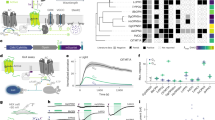Abstract
EXPERIMENTS by Katz and Miledi1 on the giant synapse of the squid stellate ganglion pretreated externally with tetrodotoxin (TTX) to block the conducted nerve impulses, and internally with tetraethylammonium (TEA) to block the potassium current, showed that a local regenerative response confined to the presynaptic terminal was obtained on depolarisation, provided that the external calcium concentration was sufficiently high. Strontium and barium substituted for calcium, and manganese and magnesium reduced the regenerative response. TEA, in the presence of TTX, also caused a massive release of acetylcholine from the frog neuromuscular junction in response to a depolarisation of the motoneurone terminals2. These results offered direct evidence for the existence in the nerve terminals of a TTX-resistant calcium channel involved in transmitter release, and suggested that TEA, by allowing an inward calcium current to become regenerative, enhanced transmitter release. The release of noradrenaline (NA) from sympathetic nerves also requires calcium, and further, strontium and barium substitute for calcium in sustaining release, and magnesium, manganese and lanthanum block release3. Moreover, TEA has also been shown to enhance NA release after electrical stimulation of sympathetic nerves4–6. These observations suggest that a calcium channel also exists in the sympathetic nerve terminals and is responsible for the release of NA. The present investigation was undertaken to determine if in the presence of TEA and TTX, depolarisation of the sympathetic nerve terminal initiates a ‘regenerative’ inward calcium current which leads to an explosive release of NA. We report that it does.
This is a preview of subscription content, access via your institution
Access options
Subscribe to this journal
Receive 51 print issues and online access
$199.00 per year
only $3.90 per issue
Buy this article
- Purchase on Springer Link
- Instant access to full article PDF
Prices may be subject to local taxes which are calculated during checkout
Similar content being viewed by others
References
Katz, B. & Miledi, R. J. Physiol., Lond. 203, 459 (1969).
Katz, B. & Miledi, R. J. Physiol., Lond. 203, 689 (1969).
Kirpekar, S. M. Prog. Neurobiol. 4, 163 (1975).
Thoenen, H., Haefely, W. & Staehelin, H. J. Pharmac. exp. Ther. 157, 532 (1967).
Kirpekar, S. M., Prat, J. C., Puig, M. & Wakade, A. R. J. Physiol., Lond. 221, 601 (1972).
Kirpekar, S. M., Wakade, A. R. & Prat, J. C. Naunyn-Schmiedebergs Archs Pharmak. 294, 23 (1976).
Garcia, A. G. & Kirpekar, S. M. J. Physiol., Lond. 235, 693 (1973).
Anton, A. H. & Sayre, D. F. J. Pharmac. exp. Ther. 138, 360 (1962).
Katz, B. & Miledi, R. J. Physiol., Lond. 192, 407 (1967).
Author information
Authors and Affiliations
Rights and permissions
About this article
Cite this article
KIRPEKAR, S., PRAT, J. Effect of tetraethylammonium on noradrenaline release from cat spleen treated with tetrodotoxin. Nature 276, 623–624 (1978). https://doi.org/10.1038/276623a0
Received:
Accepted:
Issue Date:
DOI: https://doi.org/10.1038/276623a0
This article is cited by
-
The adrenergic, cholinergic and NANC nerve-mediated contractions of the female rabbit bladder neck and proximal, medial and distal urethra
British Journal of Pharmacology (1998)
-
Pharmacological characterization of thromboxane and prostanoid receptors in human isolated urinary bladder
British Journal of Pharmacology (1998)
-
The mechanisms of enhancement and inhibition of field stimulation responses of guinea‐pig vas deferens by prostacyclin analogues
British Journal of Pharmacology (1997)
-
Studies on the role of Na+, K+ and Cl? ion permeabilities in K+-induced release of 3H-noradrenaline from rat brain slices and synaptosomes and in its presynaptic ?-adrenergic modulation
Naunyn-Schmiedeberg's Archives of Pharmacology (1981)
Comments
By submitting a comment you agree to abide by our Terms and Community Guidelines. If you find something abusive or that does not comply with our terms or guidelines please flag it as inappropriate.



